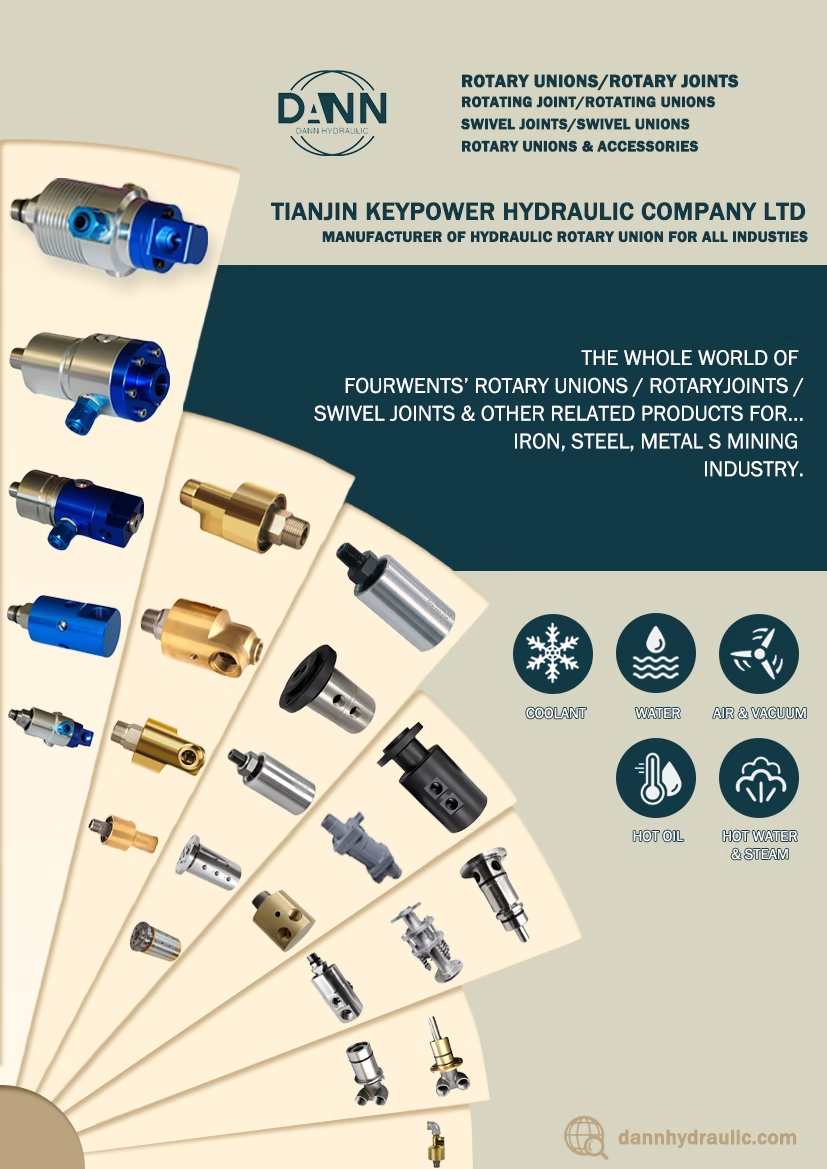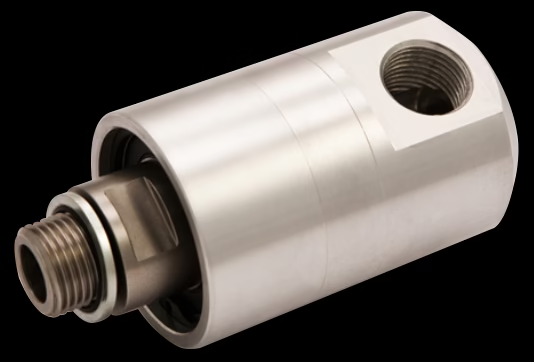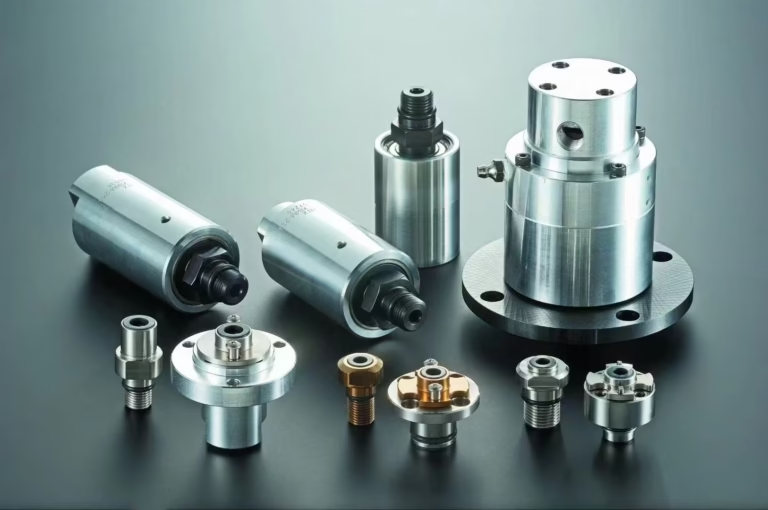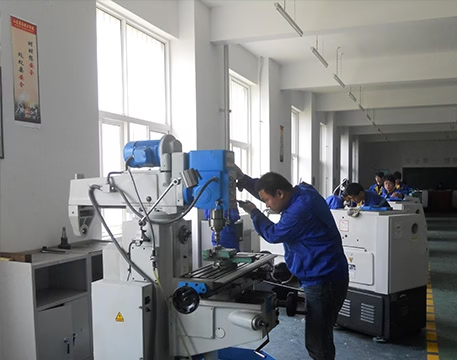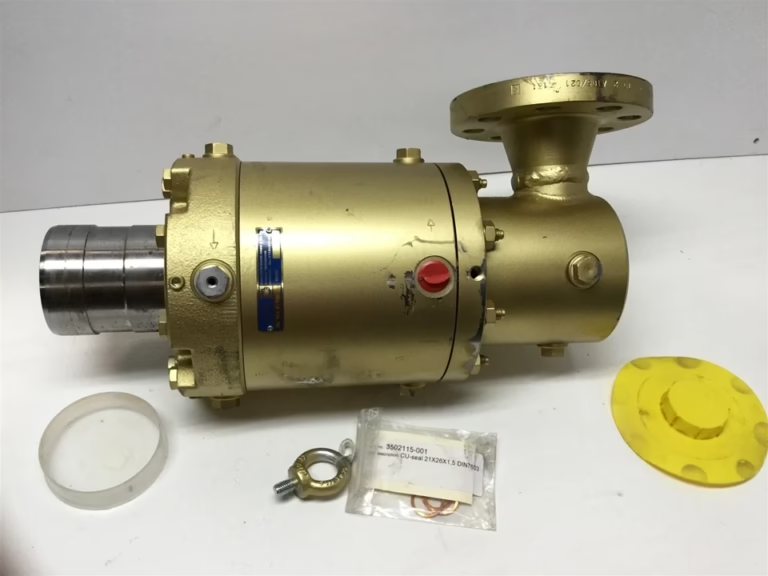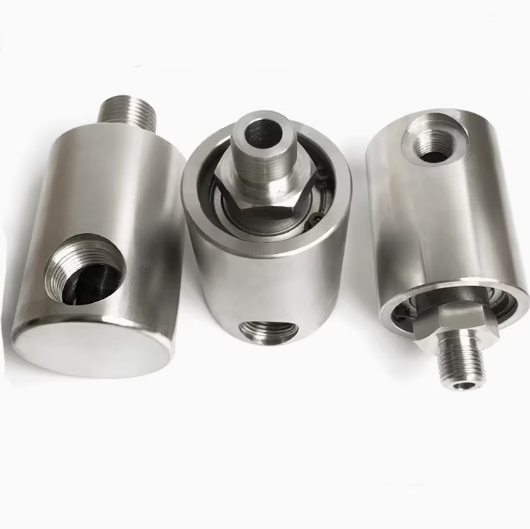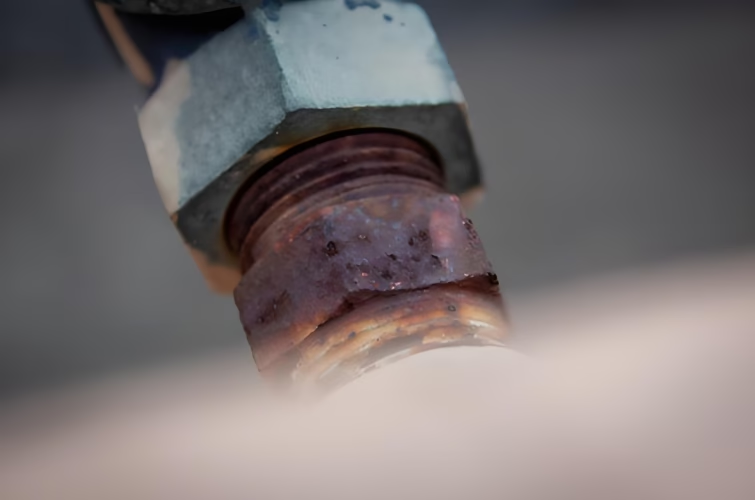What are the types of Rotary Joint?
Introduction
Rotary joints, also known as rotary unions or swivel joints, are mechanical devices that enable the transfer of fluids (liquids, gases, or steam) between stationary and rotating components in machinery. They play a critical role in industries like manufacturing, oil and gas, aerospace, and food processing, where equipment such as conveyors, wind turbines, and CNC machines require continuous motion while maintaining fluid connectivity. The design and construction of rotary joints vary based on factors such as operating pressure, temperature, rotational speed, and the type of media being transferred.
Choosing the right type of rotary joint is essential for optimizing performance, preventing leaks, and ensuring safety. In this guide, we’ll explore the different types of rotary joints, categorized by their design, application, sealing mechanisms, and operational requirements.
Working Principle of Rotary Joints
The operation of a rotary joint involves a relatively simple yet ingenious mechanism. The joint locks onto an input valve while rotating to meet an outlet. During this rotation, fluid or gas flows into the rotary joint from its source and is contained within the device during movement. When valve openings align during rotation, the media exits the union, and the process repeats with the next rotation.
Rotary joints typically function under high pressure and constant movement conditions, designed specifically to rotate around an axis. Their design can be modified to accommodate different pressure ratings (psi), rotation speeds (rpm), and valve configurations based on application requirements.
Type of rotary joint
I. Categorization by Design and Structure
Rotary joints can be classified based on their structural design, which determines how they handle fluid flow, rotation speed, and mechanical stress.
1. Single Passage Rotary Union
This Single Passage Rotary Union represents the most basic type of rotary joint, providing a single flow channel for transferring fluids between stationary and rotating components. Single passage rotary unions allow for the transfer of one media type, such as air, water, hydraulic fluid, or oil.
Definition: The simplest type, featuring a single passage for fluid input/output between a stationary housing and a rotating shaft.
Design: Consists of a rotor (rotating part), stator (stationary part), and sealing elements (e.g., O-rings, mechanical seals).
Applications:
Conveyor belts in packaging industries.
Cooling systems in injection molding machines.
Welding robots require gas or water supply during motion.
Advantages: Cost-effective, easy to install, low maintenance.
Disadvantages: Limited to one fluid type; not suitable for complex multi-fluid systems.
These simple yet reliable designs are cost-effective and widely used in applications requiring the transfer of just one medium. Their straightforward construction makes them suitable for various industrial equipment, including rotary tables, printing machinery, and packaging systems.
2. Multi-Passage Rotary Union
Unlike their single-passage counterparts, multi-passage rotary unions feature multiple flow channels type of rotary joint, enabling the simultaneous or individual transfer of different fluids. These more complex designs incorporate multiple sealing and channeling systems capable of handling various media combinations.
Definition: Designed with multiple independent fluid passages (2 to 12+ channels) to transfer multiple media (e.g., oil, air, coolant) simultaneously.
Design: Uses a modular layout with separate seals and bearings for each channel to prevent cross-contamination.
Applications:
CNC machining centers with integrated cooling and lubrication.
Aerospace actuators require hydraulic and pneumatic inputs.
Printing presses with ink, air, and water supply lines.
Advantages: High versatility for complex machinery; space-efficient compared to multiple single-channel joints.
Disadvantages: Higher cost; precise alignment required to avoid seal wear.
Multi-passage rotary unions are particularly valuable in applications requiring the transfer of different media types or where separate circuits must be maintained. They find extensive use in sophisticated industrial systems like machining centers that need a concurrent supply of multiple fluids.
3. High-Speed Rotary Union
Specifically engineered to handle elevated rotational speeds while maintaining reliable, leak-free connections, high-speed type of rotary joint is essential in applications like high-speed machining centers, spindle applications, and rotary index tables.
Definition: Engineered to handle rotational speeds exceeding 1,000 RPM (up to 10,000+ RPM in aerospace applications).
Design: Features low-friction bearings (e.g., ceramic ball bearings), balanced seals, and dynamic balancing to reduce vibration.
Applications:
Turbine generators and wind energy rotors.
Centrifuges in chemical processing.
High-speed spindles in woodworking machinery.
Advantages: Stable performance at extreme speeds; minimal heat generation.
Disadvantages: Strict tolerance requirements; regular lubrication needed.
These specialized joints employ advanced bearing and sealing systems capable of withstanding the centrifugal forces and heat generated during high-speed rotation. Their design emphasizes friction and wear reduction to extend operational life under demanding conditions.
4. High-Pressure Rotary Joints
High-pressure rotary unions are specifically designed to handle fluid pressures exceeding normal ranges. Constructed with robust materials and advanced sealing systems, these type of rotary joint ensure connection integrity under extreme pressure conditions.
Definition: Built to withstand pressures ranging from 100 PSI to over 10,000 PSI (e.g., for hydraulic systems or oil extraction).
Design: Reinforced housing (e.g., forged steel), heavy-duty seals (e.g., metal-to-metal seals), and stress-resistant bearings.
Applications:
Hydraulic presses in metal forming.
Subsea oil and gas equipment.
High-pressure cleaning systems in industrial cleaning.
Advantages: Robust for extreme environments; leak-proof under pressure.
Disadvantages: Bulkier design; higher weight and cost.
These specialized components play a vital role in applications requiring high-pressure fluid transfer, such as hydraulic systems and high-pressure cleaning equipment. Their design prioritizes safety and durability, ensuring reliable performance even in extreme operating environments.
5. High-Temperature Rotary Union
Engineered to withstand elevated temperatures, high-temperature rotary unions incorporate specialized materials, seals, and cooling mechanisms to prevent overheating while maintaining efficient fluid transfer.
These specialized joints are crucial in high-temperature processes across industries such as steel manufacturing, glass production, and plastic molding. They maintain performance integrity at extreme temperatures, protecting equipment from thermal damage while ensuring continuous operation.
II. Categorization by Sealing Mechanism
Seals are critical for preventing fluid leakage and maintaining joint integrity. Different sealing technologies suit various media, temperatures, and speeds.
1. Mechanical Seal Rotary Joints
Definition: Use a pair of precision-machined faces (rotating and stationary) pressed together to create a seal.
Design: Typically made of tungsten carbide, silicon carbide, or carbon graphite for high hardness and low friction.
Applications:
Steam systems in power plants (up to 500°C).
Chemical processing with corrosive fluids.
Food industry with sanitary requirements (e.g., dairy pasteurization).
Advantages: Excellent leak resistance; suitable for high speeds and temperatures.
Disadvantages: Sensitive to particulate contamination; requires clean fluids.
2. Packing Seal Rotary Joints
Definition: Employ compressible packing materials (e.g., graphite, braided fiber) around the shaft to create a seal.
Design: Adjustable gland nuts allow tightening to compensate for wear.
Applications:
Low-pressure water or air systems (e.g., agricultural irrigation).
Older industrial machinery with simple maintenance needs.
Advantages: Inexpensive; easy to replace packing material.
Disadvantages: Higher friction; prone to leakage at high speeds or pressures.
3. Magnetic Seal Rotary Joints
Definition: Use magnetic forces to align and press sealing faces together, eliminating the need for mechanical spring loading.
Design: Incorporates rare-earth magnets (e.g., neodymium) for contactless sealing.
Applications:
Vacuum systems in semiconductor manufacturing.
Sterile environments in pharmaceutical equipment (zero particle generation).
Advantages: Reduced wear; ideal for clean or sensitive media.
Disadvantages: Limited to low torque and moderate speeds; higher magnetic field interference risks.
III. Categorization by Fluid Media and Application
Rotary joints are engineered for specific fluids, temperatures, and industries, requiring material and design adaptations.
1. Steam Rotary Joints
Definition: Designed to handle high-temperature steam (up to 600°C) and pressure (up to 300 PSI).
Design: Uses heat-resistant materials (stainless steel 316, Inconel), anti-corrosive coatings, and expansion joints to manage thermal stress.
Applications:
Paper mills (steam-heated rollers).
Food processing (sterilization tunnels).
Power plants (turbine steam supply).
Key Considerations: Regular descaling to prevent mineral buildup; proper drainage to avoid condensate damage.
2. Hydraulic Rotary Joints
Definition: Optimized for transferring hydraulic oil in heavy machinery, enabling power transmission during rotation.
Design: High-pressure-rated seals, abrasion-resistant bearings, and compact layouts for space-constrained systems.
Applications:
Excavators and cranes (rotating booms).
Injection molding machines (hydraulic actuators).
Wind turbines (pitch control systems).
Key Considerations: Fluid viscosity matching; filtration to prevent seal damage from particulate matter.
3. Pneumatic Rotary Joints
Definition: Designed for air or gas transfer, often in high-speed, low-pressure applications.
Design: Lightweight materials (aluminum, brass), low-friction seals, and built-in air filters to prevent contamination.
Applications:
Pneumatic tools (e.g., air-powered drills).
Packaging machinery (air cylinders for motion control).
Automotive assembly lines (robotic grippers).
Key Considerations: Moisture management to avoid rust; pressure regulation for consistent performance.
4. Cooling Media Rotary Joints
Definition: Used for transferring water, coolant, or refrigerants in temperature-control systems.
Design: Corrosion-resistant materials (stainless steel, PVC), laminar flow channels to prevent turbulence, and leak detection sensors.
Applications:
CNC machine tool spindles (temperature stabilization).
Plastic extrusion lines (cooling rollers).
Medical imaging equipment (MRI magnet cooling).
Key Considerations: Anti-freeze protection for low-temperature use; regular flush to remove sediment.
5. Water Rotary Joints
Water rotary joints are designed for applications requiring the transfer of water between stationary and rotating parts. Commonly found in industries like paper manufacturing, steel production, and cooling systems, these joints handle high flow rates and temperature variations effectively. Their robust construction ensures longevity and reliability in demanding environments.
Applications:Paper mills/Steel processing plants/Cooling systems in various industries.
6. Air Rotary Joints
Air rotary joints facilitate the transfer of compressed air in systems requiring pneumatic power. They are lightweight and capable of handling high-speed rotations, making them ideal for applications in pneumatic tools, industrial machinery, and robotics. These joints ensure reliable air transfer, contributing to the smooth operation of equipment.
Applications:Pneumatic tools/Industrial automation/Robotic arms.
7. Oil Rotary Joints
Oil rotary joints are utilized for transferring lubricants or thermal oils within machinery. They are essential in industries like automotive manufacturing, plastics, and metal processing, where consistent lubrication or temperature control is critical. These joints are designed to prevent contamination and ensure seamless oil flow.
Applications:Automotive assembly lines/Plastic extrusion machines/Metalworking equipment.
8. Hydraulic Oil Rotary Joints
Hydraulic oil rotary joints are robust components capable of handling high-pressure hydraulic fluids. They are crucial in hydraulic systems for equipment like cranes, excavators, and heavy machinery, allowing efficient hydraulic oil transfer while accommodating the movement of rotating parts.
Applications:Construction machinery/Material handling equipment/Agricultural machinery.
IV. Categorization by Industry and Specialized Use Cases
Different industries have unique requirements, driving the development of specialized rotary joints.
1. Industrial Rotary Joints
Scope: General-purpose joints for manufacturing, mining, and construction.
Design: Robust construction with cast iron or carbon steel housing; suitable for harsh environments with dust, moisture, or vibrations.
Applications: Conveyor belts in mining operations/Cement kilns (rotating drums with air/steam supply)/Agricultural machinery (irrigation pivots).
2. Sanitary Rotary Joints
Scope: Designed for food, beverage, and pharmaceutical industries, meeting strict hygiene standards (e.g., FDA, 3A, EHEDG).
Design: Smooth surface finishes (Ra ≤ 0.8μm), electropolished stainless steel 316L, and quick-disconnect fittings for easy cleaning.
Applications:
Dairy processing (pasteurization tanks)/Pharmaceutical mixers (sterile fluid transfer)/Breweries (fermentation vessel rotations).
Key Considerations: Regular CIP (Clean-in-Place) and SIP (Sterilize-in-Place) protocols; no crevices for bacterial buildup.
3. Aerospace Rotary Joints
Scope: High-precision joints for aircraft and spacecraft, prioritizing lightweight design and reliability in extreme conditions.
Design: Titanium or aluminum alloy construction; hermetic seals for vacuum resistance; minimal torque for control surfaces.
Applications:
Aircraft wing pivots (hydraulic and electrical signal transfer).
Satellite antennas (rotating RF connectors).
Missile control systems (high-frequency signal transmission).
Key Considerations: vibration and thermal cycling testing.
4. Subsea Rotary Joints
Scope: Engineered for underwater environments (up to 10,000 meters depth), resisting high pressure and corrosion.
Design: Composite or nickel-alloy housing; double-seal systems with pressure-compensating fluids; anti-fouling coatings.
Applications:
Offshore oil rigs (rotating riser pipes).
Underwater drones (thruster fluid connections).
Submarine communication cables (rotary electrical connectors).
Key Considerations: Regular inspection for marine growth; resistance to hydrogen sulfide (H2S) in oil fields.
V. Key Factors in Choosing the Right Rotary Joint
Choosing the appropriate rotary joint for a specific application involves evaluating several factors. To ensure optimal performance, consider these criteria when selecting a rotary joint:
Fluid Media: Type (liquid, gas, steam), viscosity, and chemical composition (corrosive, abrasive, etc.).Ensure compatibility with the fluid or gas being transferred.
Operational Parameters:
Pressure (PSI/bar) and temperature (°C/°F). Select a joint that can withstand the system’s pressure and temperature conditions.
Rotational speed (RPM) and motion type (continuous vs. oscillating). Consider the rotational speed requirements to ensure the joint can handle the operational demands.
Environmental Conditions: Dust, moisture, vibrations, or exposure to chemicals.
Industry Standards: Compliance with FDA, API, ATEX, or other regulatory requirements.
Maintenance Needs: Ease of seal replacement, lubrication intervals, and downtime costs.
Number of Passages: Determine if multiple fluid channels are necessary for the application.
Mounting and Space Constraints: Assess the available space and mounting options to ensure proper installation and operation.
VI. Maintenance Best Practices for Longevity
Regular Inspection: Check for leaks, unusual noise, or temperature spikes.
Lubrication: Use manufacturer-recommended grease/oil for bearings and seals (e.g., food-grade lubricants for sanitary applications).
Cleaning: Flush contaminants from cooling or hydraulic lines; descale steam joints annually.
Seal Replacement: Follow OEM guidelines for seal life (e.g., every 1,000 hours in high-speed applications).
Conclusion
Rotary joints are indispensable in modern industrial machinery, with diverse types designed to meet specific operational, environmental, and regulatory needs. By understanding their classifications—by design, sealing mechanism, fluid media, and industry application—you can select the right joint to enhance efficiency, safety, and durability.
Whether you are engineering a high-pressure hydraulic system, a sanitary food processing line, or an aerospace component, prioritizing factors like material compatibility, sealing technology, and maintenance requirements will ensure optimal performance.

